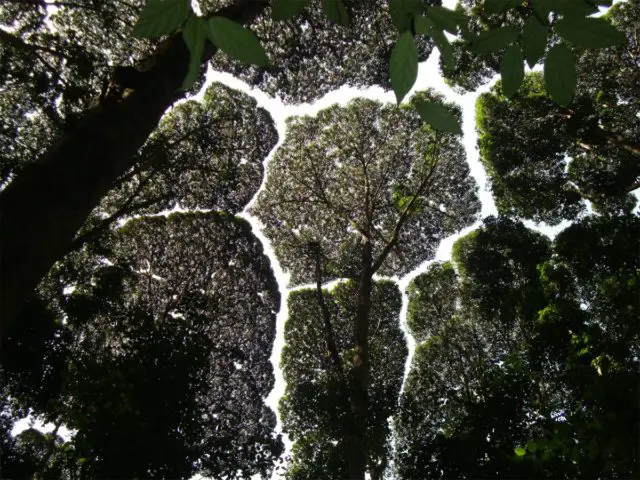Nature is awesome! It surprises us with its mathematical accuracy in the form of seashells, with incredible adaptations such as the change of color of the chameleon, with the dance of the tides, or with the elongated peaks of the hummingbirds which fit perfectly into the tubular corollas of the flowers. Nature is something that we still do not understand because, perhaps, it is not within our reach.
Another of the spectacular behaviors that it offers to us happens to many meters of the ground, to the height of the canopies of the trees. Perhaps at some point, we have noticed and we have not given much importance -which would not be strange among us. This phenomenon was not discovered until the early 20th century.
It took centuries until the human being looked up as he walked through the forest and observed -with great surprise- that the treetops avoided touching each other.
This behavior is technically known as canopy disengagement or intercrown spacing, but it sounds more poetic to call it canopy shyness. Certainly, it seems an appropriate word to describe the phenomenon, because the trees seem to take care of the distances with millimeter precision, avoiding that the branches collide with those of the neighbor.

Canopy shyness occurs mainly between trees of the same species, but it has also been observed among specimens of different species. It has been proven very repeatedly in the conifers of Alaska or in the larches of Japan and extended in the tropical latitudes, where the luxuriance of the forests forces to fight to obtain a ray of light. Where the trees appear very close to one another, it is easier to observe the phenomenon of shyness, which still has no explanation.
In the 1950s, the Australian botanist Maxwell Ralph Jacobs observed canopy shyness in eucalyptus and thought that it was due to the abrasion that leaves produce when rubbing against one another. This first theory seems to have been discarded. Later, another botanist, the Frenchman Francis Hallé, proposed in his work L’Architecture des Arbres (Architecture of Trees) that arboreal shyness responds to genetic causes.
Hallé argued that the shape of the canopy is never random. According to him, each tree has its specific development program controlled by its genes.
One of the most widespread theories holds that the separation of treetops between trees is something conscious on the part of the species but, if they do it competing in search of the best light or cooperating, helping each other, it is something that is not completely understood.
Are the trees collaborating so that all the canopies of their branches receive light? Or do they avoid playing because they compete with each other? We do not know it yet, but for sure more research has to be done with regard to this.
It is also thought that this separation between cups is done naturally to prevent the spread of leaf-miners, larvae that live in the tissue of the leaves, and that cause damage to trees. The last theory -the one most accepted by the scientific community at present- maintains that the timidity is due to the fact that the trees emit through the leaves some substances that serve to coordinate the growth with other specimens.
These substances would be responsible for phenomena such as shyness or the seeds are born at the same time in all trees. In some way, the theory holds that tree species communicate with each other and coordinate.
This proposal is not proven, but it makes sense from the ecological point of view. If the theory were true, it would be shown that, in Nature, the law of the strongest ones does not always prevail. Sometimes, collaboration is more useful.
Canopy shyness is another example that supports the idea that Nature works in a geometric way. Observing the shapes that draw the treetops when they avoid colliding, there is no doubt that there is a mathematical basis behind this behavior as in the movement of the dunes of the deserts, in the structure of the snowflakes, or in the growth of the coral reefs. Nature is guided by the perfection of numbers!
Discovering the secret formula of its operation is something that we still have to achieve. And it is fascinating to imagine that one day we will achieve it.
